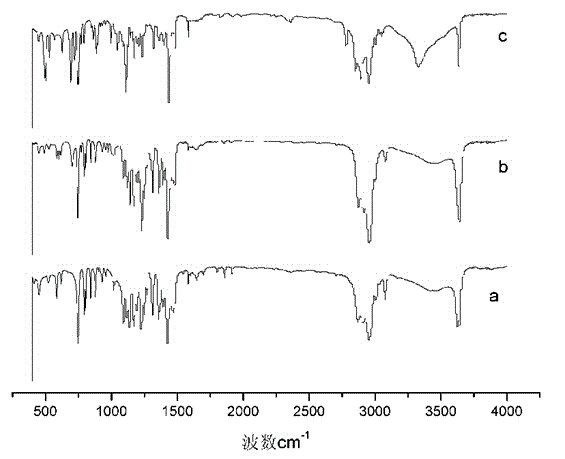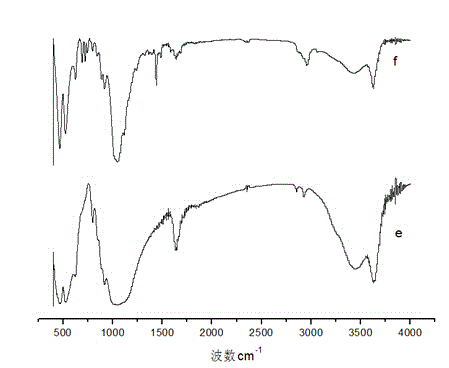Polyolefin containing hindered phenol phosphonium salt modified montmorillonite antioxidant as well as preparation method of polyolefin
A technology of montmorillonite and quaternary phosphonium salt, applied in the field of polyolefin and its preparation, can solve the problems of short action time, poor stability, limited use and the like, and achieve the effects of less pollution, good processing resistance, and not easy to migrate
- Summary
- Abstract
- Description
- Claims
- Application Information
AI Technical Summary
Problems solved by technology
Method used
Image
Examples
Embodiment 1
[0028] (1) Synthesis of benzyl chloride hindered phenol: in N 2 Under protection, add 10 parts of 2,6 di-tert-butylphenol (Zibo Shibang Chemical Co., Ltd.), 20 parts of paraformaldehyde, and 5 parts of n-heptane into a 250 mL three-necked flask equipped with magnetic stirring, condenser and thermometer , 0.01 part of initiator, the temperature was raised to 70°C, and the 2,6 phenol was completely dissolved under magnetic stirring. Add 3 parts of concentrated hydrochloric acid dropwise to the above solution, continue the constant temperature reaction at 70°C for 12 hours, then cool the reaction solution to room temperature, separate the liquids, extract the water phase with 20 parts of ethyl acetate and mix it with the organic layer, and wash the organic layer with deionized water until neutral. properties, washed with saturated brine, anhydrous Na 2 SO 4 After drying, the solvent was recovered by distillation under reduced pressure, and vacuum-dried at 30°C for 12 hours to o...
Embodiment 2
[0038] The difference between this implementation and Example 1 is that in step (1), the reaction temperature is changed to 80°C, the reaction time is 18h, the solvent is changed to n-hexane, the dosage is 17.5 parts, the initiator is 0.3 parts, paraformaldehyde 50 parts, hydrochloric acid 0.5 parts, 50 parts of ethyl acetate. In step (2), the temperature is 50°C, the reaction time is 3 hours, the organic phosphine is 12 parts, the solvent is changed to N,N dimethylformamide, the dosage is 10 parts, and petroleum ether is 50 parts. In step (3), the water bath temperature is 70°C, the reaction time is 24 hours, the solvent is changed to 500 mL of anhydrous methanol, and the hindered phenolic quaternary phosphonium salt is 4.5 parts. In step (4), the added amount of the hindered phenolic quaternary phosphonium salt modified montmorillonite antioxidant is reduced to 0.3 parts.
[0039] The thermal and oxidative aging properties are shown in Table 1. It can be seen from Table 1 ...
Embodiment 3
[0041] The difference between this implementation and Example 1 is that the reaction temperature in step (1) is changed to 90°C, the reaction time is 24h, the solvent is changed to 25 parts of toluene, 0.1 parts of initiator, 100 parts of paraformaldehyde, 1.5 parts of hydrochloric acid, acetic acid 30 parts of ethyl ester. In step (2), the temperature is 60° C., the reaction time is 4 hours, the solvent is changed to tetrahydrofuran, 30 parts of petroleum ether, and 11 parts of organic phosphine. In step (3), the temperature of the water bath is 80° C., the reaction time is 12 hours, 450 mL of deionized water, and 5.5 parts of hindered phenolic quaternary phosphonium salts. In step (4), the added amount of hindered phenolic quaternary phosphonium salt modified montmorillonite antioxidant is reduced to 0.1 part.
PUM
 Login to View More
Login to View More Abstract
Description
Claims
Application Information
 Login to View More
Login to View More - Generate Ideas
- Intellectual Property
- Life Sciences
- Materials
- Tech Scout
- Unparalleled Data Quality
- Higher Quality Content
- 60% Fewer Hallucinations
Browse by: Latest US Patents, China's latest patents, Technical Efficacy Thesaurus, Application Domain, Technology Topic, Popular Technical Reports.
© 2025 PatSnap. All rights reserved.Legal|Privacy policy|Modern Slavery Act Transparency Statement|Sitemap|About US| Contact US: help@patsnap.com



